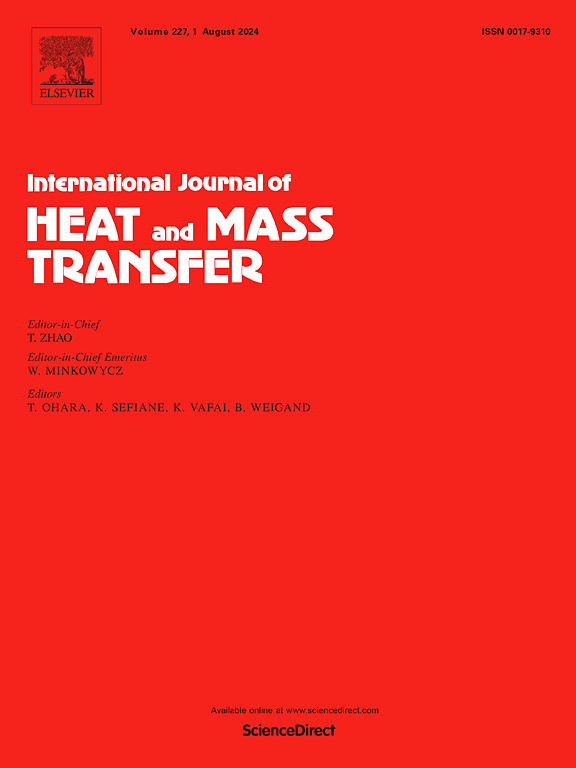海洋运动条件下泪滴结构PCHE中超临界LNG的动态热输运和湍流特性
IF 5.8
2区 工程技术
Q1 ENGINEERING, MECHANICAL
International Journal of Heat and Mass Transfer
Pub Date : 2025-07-30
DOI:10.1016/j.ijheatmasstransfer.2025.127589
引用次数: 0
摘要
我们的研究调查了两种常见的复杂海洋运动——滚动加起伏和俯卧加起伏——以及它们对具有凹窝和突起的泪滴型印刷电路热交换器内超临界液化天然气流动的影响。由旋转和平移运动产生的惯性力通过用户定义的函数并入Navier-Stokes方程,以模拟现实的海洋条件。综合统计分析瞬态和时间平均物理参数揭示了这些动态条件下的热传导效率的见解。从传热、湍流和热力学不可逆性的角度出发,研究的关键指标包括湍流热流密度、努塞尔数、普朗特数、范宁摩擦系数、压降、湍流动能、熵产和场协同角度。结果表明,与俯仰加起伏相比,翻滚加起伏引起的湍流热通量波动更大,热扩散速度更快。相反,俯仰加起伏时范宁摩擦系数波动较小,减少了流致压力损失。滚动加起伏模式增强了剪切、混合和摩擦效应,传热以对流为主,而俯仰加起伏模式则表现为对流和传导交替。两种运动下的不可逆能量损失主要由温度梯度驱动。泪滴凹陷比泪滴突出产生更大的换热熵,而黏性耗散熵则相反。换热效率和流动阻力评价表明,泪滴型凹窝优于凸窝,在滚动加起伏运动下综合性能指标为1.02 ~ 1.08,在俯仰加起伏运动下综合性能指标为1.04 ~ 1.06。本文章由计算机程序翻译,如有差异,请以英文原文为准。
Dynamic heat transport and turbulence characteristics of supercritical LNG in a teardrop-structured PCHE under oceanic motion conditions
Our study investigates two common complex oceanic motions—rolling plus heaving and pitching plus heaving—and their effects on supercritical LNG flow within a teardrop-configured printed circuit heat exchanger featuring dimples and protrusions. Inertial forces arising from rotational and translational motions are incorporated into the Navier-Stokes equations via user-defined functions to simulate realistic ocean conditions. Comprehensive statistical analyses of transient and time-averaged physical parameters reveal insights into thermal transfer efficiency under these dynamic conditions. Key metrics examined include turbulent heat flux, Nusselt number, Prandtl number, Fanning friction coefficient, pressure drop, turbulent kinetic energy, entropy generation, and the field synergy angle, from perspectives of heat transfer, turbulence, and thermodynamic irreversibility. Results show that rolling plus heaving induces more intense fluctuations in turbulent heat flux and accelerates thermal diffusion compared to pitching plus heaving. Conversely, the lower fluctuation of the Fanning friction coefficient in pitching plus heaving reduces flow-induced pressure losses. The rolling plus heaving mode enhances shear, mixing, and friction effects, with heat transfer dominated by convection, whereas the pitching plus heaving mode exhibits alternating convection and conduction. Irreversible energy losses are primarily driven by temperature gradients under both motions. Teardrop dimples generate larger heat transfer entropy than teardrop protrusions, while the opposite trend is observed for viscous dissipation entropy. Evaluations of heat exchange efficiency and flow resistance indicate that teardrop dimples outperform protrusions, with integrated performance indices ranging from 1.02 to 1.08 under rolling plus heaving and 1.04 to 1.06 under pitching plus heaving motions.
求助全文
通过发布文献求助,成功后即可免费获取论文全文。
去求助
来源期刊
CiteScore
10.30
自引率
13.50%
发文量
1319
审稿时长
41 days
期刊介绍:
International Journal of Heat and Mass Transfer is the vehicle for the exchange of basic ideas in heat and mass transfer between research workers and engineers throughout the world. It focuses on both analytical and experimental research, with an emphasis on contributions which increase the basic understanding of transfer processes and their application to engineering problems.
Topics include:
-New methods of measuring and/or correlating transport-property data
-Energy engineering
-Environmental applications of heat and/or mass transfer

 求助内容:
求助内容: 应助结果提醒方式:
应助结果提醒方式:


